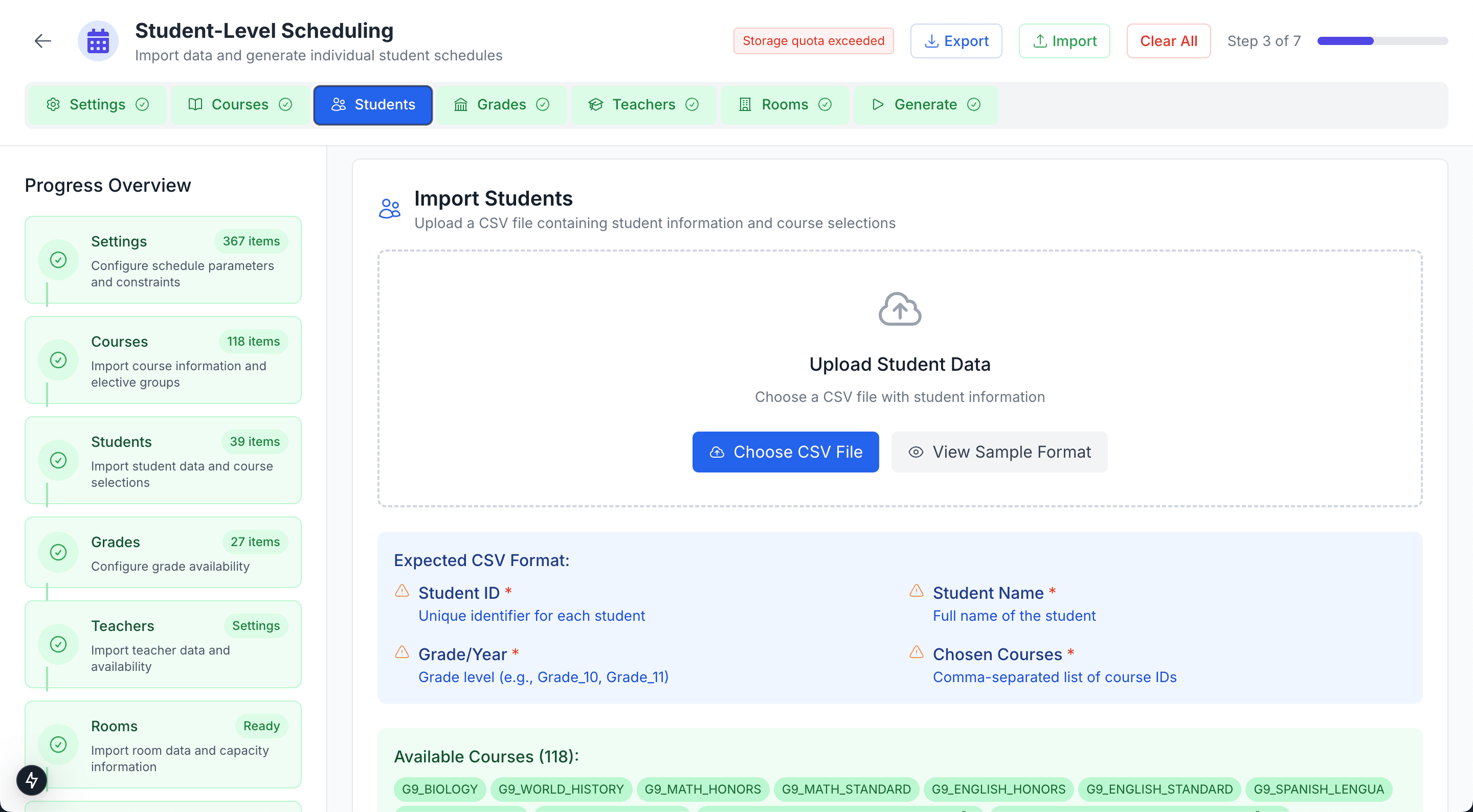Step 3: Students Configuration
Student configuration is the heart of individual student scheduling. Here you'll import your student roster along with each student's individual course selections, creating the foundation for personalized timetables.
Understanding Student Data Requirements
The Individual Student Schedule Generator needs specific information about each student to create conflict-free, personalized schedules:

Student data import interface with sample records
Essential Student Information
Student ID: Unique identifier for each student
- Use your institution's existing student ID system
- Ensure IDs are consistent with other school systems
- Avoid changing IDs after scheduling begins
Full Name: Student's complete name as it should appear on schedules
- Include first name, last name, and middle initial if used
- Use consistent formatting across all student records
- Consider how names will display on printed schedules
Grade Level: Current academic grade or year
- Must match the grade levels defined in your course catalog
- Used to validate course enrollment eligibility
- Helps organize students for reporting and analysis
Course Selection Lists
Selected Courses: Each student's chosen courses using exact course codes
- Must match course codes from your configured course catalog
- Include both mandatory and elective courses
- Verify students meet any prerequisite requirements
Course Selection Strategy: Students typically choose a mix of mandatory courses (required for their grade) and elective courses (based on interests). The system will automatically enroll students in mandatory courses and create sections for electives based on demand.
Data Import Methods
Individual Student Entry
For smaller schools or when making specific updates:
- Add New Student: Click the "Add Student" button
- Enter Details: Fill in student ID, name, and grade
- Select Courses: Choose from your configured course catalog
- Save: Confirm the student record
Bulk Student Import
For larger student populations, use CSV file import:
Required CSV Structure:
Student_ID,First_Name,Last_Name,Grade,Course_Selections
2024001,Sarah,Johnson,10,"MATH-101,ENG-ADV,BIO-LAB,ART-101,SPAN-BEG"
2024002,Michael,Chen,11,"CALC-101,PHYS-ADV,CHEM-LAB,HIST-MOD,COMP-SCI"
2024003,Emma,Rodriguez,9,"MATH-BAS,ENG-101,BIO-101,PE-101,MUS-101"
Import Validation
The system validates student data during import:
Automatic Checks:
- Unique Student IDs: No duplicate students
- Valid Course Codes: All courses exist in catalog
- Grade Eligibility: Students can enroll in selected courses
- Schedule Feasibility: Course selections can fit in available periods
Common Validation Errors:
- Course code doesn't match catalog
- Student grade not eligible for selected course
- Too many course selections for available schedule slots
- Missing required mandatory courses
Data Integrity: Import validation errors must be resolved before proceeding. Incorrect student data can result in impossible-to-schedule conflicts or students missing required courses.
Student Course Selection Strategies
Balanced Selection Approach
Recommended Mix:
- 4-6 mandatory courses (core subjects)
- 2-4 elective courses (interests and specialization)
- 1-2 backup electives (in case of scheduling conflicts)
Managing Course Demand
High-Demand Courses: Popular electives that many students request
- The system automatically creates multiple sections as needed
- Consider teacher availability when many sections are required
- Monitor room capacity for courses needing special facilities
Low-Demand Courses: Courses with few student selections
- May be combined with other grades or scheduled less frequently
- Consider minimum enrollment requirements
- Provide alternative courses for affected students
Special Considerations
Students with Special Needs
Accommodation Requirements:
- Extended time between classes for mobility
- Specific room accessibility needs
- Modified schedules with reduced course loads
- Aide or support staff scheduling coordination
Implementation: Note special requirements in student records. The system will consider these constraints during schedule generation.
Transfer Students and Mid-Year Changes
New Enrollments: Students joining after initial scheduling
- Add individual student records with course selections
- System will fit new students into existing sections when possible
- May require creating additional sections for high-demand courses
Course Changes: Students modifying their course selections
- Update individual student records
- Consider impact on section enrollment numbers
- May need to regenerate affected portions of the schedule
Grade-Level Transitions
Advanced Students: Lower-grade students taking higher-level courses
- Ensure course prerequisites are met
- Consider social and academic integration factors
- Verify graduation requirement compliance
Data Quality and Review
Pre-Import Checklist
- Student IDs match school information system
- All course codes exist in your course catalog
- Grade levels are accurate and current
- Mandatory courses are included for all eligible students
- Elective selections are realistic for schedule capacity
Post-Import Validation
- Total student count matches expectations
- Course demand distribution looks reasonable
- No validation errors or conflicts
- Special accommodation needs are noted
- Student data can be successfully processed
Student Data Preview
Review key statistics before proceeding:
- Total Students: Count by grade level
- Course Demand: Most and least popular courses
- Average Course Load: Periods per student
- Section Projections: Estimated sections needed per course
Next Steps
With student data successfully imported and validated, you're ready to move to Grades Configuration where you'll set up grade-level availability and restrictions.
Quick Checklist:
- All student records imported successfully
- Course selections validated against course catalog
- No validation errors or conflicts
- Student data statistics look reasonable
- Special needs and accommodations noted
- Ready to proceed to grade configuration